Dangerous Journeys: Mythus by Tolan
| 1 | Introduction |
| 2 | Part I |
| 3 | Part II |
| 4 | Part III |
Introduction
Original SA post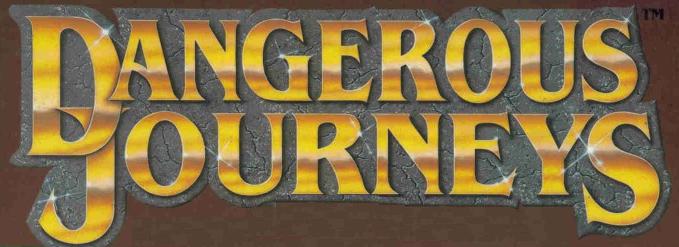
Dangerous Journeys: Mythus
Dangerous Journeys: Mythus is the fantasy component of a planned universal role-playing system by Gary Gygax (EGG). Dangerous Journeys (DJ) was the name for the overall system; Mythus is the name of the fantasy bit. The other components never got published (for reasons elucidated below), so Mythus is the entirety of the game. As a result, it’s rarely called Mythus--most people just say “Dangerous Journeys.”
(Most of this is taken from here , and is obviously from EGG’s point of view. I don’t care about DJ enough to research the other side of the story, though.)
Gary Gygax’s post-AD&D game creation history was bumpy, to say the least. After he was ousted from TSR, his attempts at recapturing the lighting in a bottle that was D&D and AD&D were mediocre at best. The first, Cyborg Commando , was published in 1986-87 by his own company, New Infinities Productions. The game was pretty much universally panned, and NIP folded soon after publication for unrelated reasons. (I actually wish someone would review this; I’ve heard it’s just
 levels of unplayable.)
levels of unplayable.)
His next project, Unhallowed, was a horror RPG. NEC and JVC licensed the game for fantasy, however, and so EGG quickly came up with the “Dangerous Dimensions” name for the overall system and put together (with Dave Newton) a fantasy variant called Mythus. They lined up Game Designers’ Workshop (GDW)--known mostly for Traveller and Twilight: 2000 in the RPG world--as the publishers.
After TSR became aware of the game, EGG preemptively changed the name to “Dangerous Journeys,” as he believed that TSR would claim that the DD acronym was too close to D&D. NEC and JVC agreed, and the change was made; TSR sued for copyright infrigement anyway. Interestingly--and smartly--TSR only sued the RPG publishers, not NEC and JVC. Those two withdrew from their agreements, leaving EGG & GDW high and dry in the face of mounting legal fees.
After some legal and financial wrangling, TSR was generally successful: EGG & GDW could publish Mythus (as the books for that were already produced), but no further work could be done for the game system. As Gary put it, the game was “killed before it had a chance.” (I’m not so sure it had a chance to begin with, since it is one of the most loquacious RPGs I’ve ever seen. Gygax is famous for never using a 5-cent word when a 25-cent one will fit, and it’s on full display here.) He and GDW came to an agreement with TSR, and the seven products published while the suit was ongoing would be the last in the game line.
Gary went on to produce Lejendary Adventure in 1999, a game that had some similarities to DJ, which was slightly more successful. (I think I actually own at least one book for this, and remember being unimpressed at best.) GDW closed its doors in 1996, mostly due to burn-out on the part of the principals, though I’d speculate the horrible crash in the wargame market and the financial stress of the DJ fiasco had a lot to do with that burn-out.
So basically EGG put out a system. TSR/Lorraine Williams really hated that, despite it being pretty much nothing like AD&D except for the writing style. They sue, Gary’s pockets can’t compete with TSR’s millions, and DJ gets a bullet in the head.
Dangerous Journeys isn’t a bad game, but it’s needlessly complex and ridiculously verbose and doesn’t really do anything new--even at the time it wasn’t all that groundbreaking. The seven published products are:
-
Mythus
(core rulebook)
-
Mythus Magick
(the full magic system)
-
Epic of Aerth
(the official campaign world)
-
Necropolis and the Land of Aegypt
(a long and tough Egyptian-centered campaign; later republished as a d20 campaign)
-
Mythus Bestiary
(creatures and monsters)
-
GMs Screen
-
Mythus Prime
(a simplified version of the core rules, which are already in the core rules; this just published them separately)
Of these, I own the first four and the GM’s Screen. I’ll be reviewing all of the ones I own and can get my hands on, though I’m not sure I’ve got everything that came with the GM’s Screen. I'll note that I've never actually played Mythus, despite owning it for 20 years.
Next Time: Mythus! -or- 414 pages of 8-point type
Part I
Original SA post
Dangerous Journeys: Mythus - Part I
Before jumping into the game itself, some comments about the presentation. Dangerous Journeys is a dense book. It’s 414 pages, the layout is two column with (I think) 8 point type, and there’s a fair amount of art (both color and black & white). The art is generally competent, and doesn’t often fall into the usual fantasy tropes. Some of it, particularly the stuff by Janet Aulisio, is exotic and evocative.
The vast majority of the book looks like this:
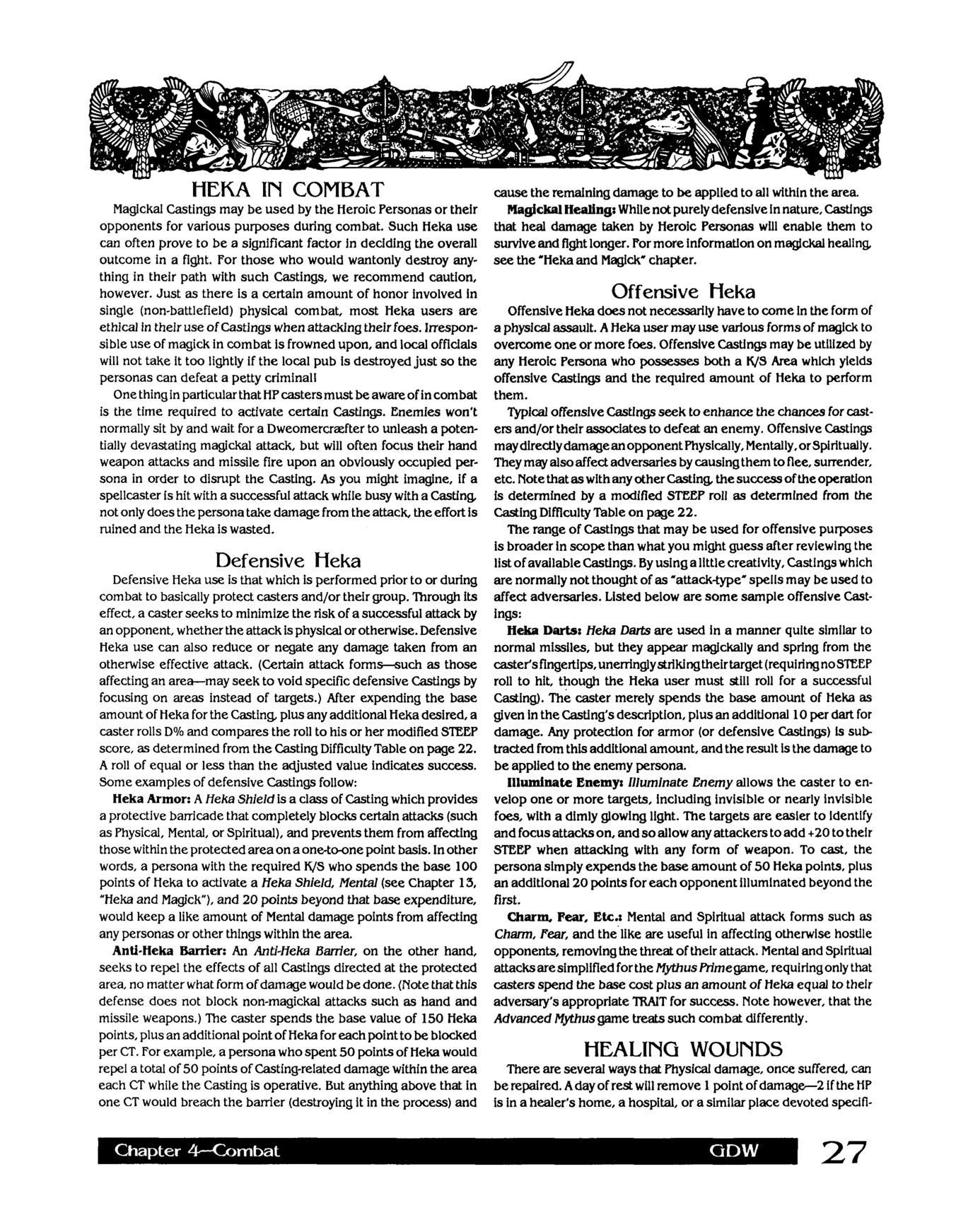
It’s functional, and there’s a TOC and a couple of indexes (major topics & charts/tables), but good lord is it eye-drooping to read for any length of time. And you will be reading it for a while, because it’s Gygax.
We start off with the usual introductory material. First, there’s a brief introduction by Lester Smith, who was the editor at GDW for Mythus. He’s pretty complimentary towards things, and extols how new and fabulous the DJ system is.
Lester Smith posted:
But in the Dangerous Journeys system, Gary has outdone his earlier work [referring to 1e AD&D] by opting for a different approach. In this system--and hence in the Mythus game--he uses something more like a Descriptive Grammar. It tells you what people are capable of doing; and because people really do lots of different things, it is naturally open ended. Or, to use another musical metaphor, it is like a jam session in which one mythic vision provides the unity, but the individual musicians are free to improvise upon that theme--and any sort of musical instrument is allowed.
After that gushing praise, we get a quick intro from Gary, discussing what kind of tone he’s going for:
EGG posted:
Welcome to the Mythus fantasy roleplaying game. There are magickal worlds awaiting within. There are worlds of palace intrigues, subterranean adventures, places which time has forgotten, and whlmslcal "counter-worlds" where winged sprites and monstrous things of evil dwell. Swordplay and witchcræft, dragons and giants, alchemy and conjuration, the Seelie Court of Phæree and the temples of demon-servers--all these things and more are just the turn of a page away. While most people of our world don't know it, there is another world connected to ours by minor dimensional irregularities, weaknesses in the fabric of the multiverse, if you will. Sometimes strange things happen to pass through these portals, and thus we have tales of sea monsters, "little people," and the like. More frequently, though, people from here step into the beyond, disappearing from Earth forever, lost without a trace. Come with us now to visit the most magickal of the otherworlds connected to our own, an alternate world called Ærth. It is a place of exciting adventure and wild things, but when you have concluded your sojourn there, your home dimension remains at hand, awaiting your return. First though, you must learn how to conduct yourself in realms of swords & sorcery!
The Mythus roleplaying game is based on fantasy, myth, and legend. If you've ever enjoyed reading Robert E. Howard, J.R.R. Tolkein, or myths and fairy tales, then you have an inkling of what's in store for you within. Likewise, if you've found excitement in films such as Dragonslayer, The Three Musketeers, Excalibur, Conan The Barbarian, Robin Hood, or Thief Of Baghdad, then you'll love this game. If you have never played a roleplaying game before, you'll find it to be very different from any game you've ever played before (we promise!). You can be certain that you wlll be most pleasantly surprised. On the other hand, if you've already experienced the enjoyment of fantasy roleplaying games, the Mythus game will brlng you new and innovatlve approaches to your cherished form of entertainment. There are complexities herein which will prove realistic, sophisticated, and satisfying to the most demanding expert. Yet the game is presented and explained clearly enough to be easily learned by complete newcomers.
Some of these statements are true, and some are lies lies lies.
After this we get the standard “What is a Roleplaying Game?” section, and a description of the role of the Gamemaster and the Roleplayers. We learn that PCs are Heroic Personas in DJ, and that they do things. But first, let’s talk about the setting! The GM description is about twice as long as the player description, and the “Game Premise” section is about four times as long as both of them. There’s no question where Gary’s focus lies.
The setting for Mythus is very explicitly laid out. It’s the Ærth mentioned in the preface. There is almost no support within the game for settings other than Ærth; there isn’t even a reference to creating your own if you like. Basically, Ærth is Earth, but with magick (called “Heka” in DJ). The geography is roughly the same, the political landscape is roughly the same, etc. History is even roughly the same, though Ærth is about a thousand years behind present-day Earth. Also, there’s an attempt to give things a “late Renaissance” feel that is weirdly shoehorned in. Most of the published adventures are set in Ægypt and the middle east region, which has a very different theme than Renaissance Europe.
How does Heka make things different? Well, there’s all kinds of magical monsters, there’s links to the faerie realm of Phæree, Ærth is hollow and has a huge underground area. There’s also magickal Portals to pretty much every world in the multiverse--the usual “alternate realities created by different outcomes” setup--which is very obviously an excuse to tie in the other (planned) games in the DJ line.
Next we get some random notes about various roleplaying topics. First, there’s mention of Mythus Magick , which is the “full version” of the magick rules and Epic of Ærth , which is the complete setting guide. Then there’s a brief blurb about “Basic and Advanced Games,” describing the intended audiences for each. Mythus Prime (the basic rules) are for newbies or people that just want to get into it; Advanced Mythus (the full rules) are for RPG vets or people with lots (LOTS) of patience. There’s a short glossary next, covering Personas (three kinds: Heroic Persona [HP] are the players, Other Persona [OP] are everyone else, Evil Persona [EP] are the villains and are a subset of the OPs), Sheets (which are just the character sheet--excuse me, Heroic Persona Sheet--and various other forms that games in the 90s loved to include for managing your game), and Dice. The Dice section is the basic “1d4 means blah blah” and a detailed discussion of d%, d3, and d5. There’s nothing particularly unusual about these in the game, and they work the way you’d think. For d3 and d5 the rolling mechanics are provided (1d6/2, round down, etc), and they also provide charts for the results.
The last (and perhaps most ominious) part is a suggestion that having access to a photocopier and a pocket calculator will be helpful for Advanced Mythus.
Milieu count: 3
Next up: Mythus Prime -or- This isn’t all that bad--oh, wait, gypsies.
Part II
Original SA post
Dangerous Journeys: Mythus - Part II
So after that oh-so-tantalizing introduction, we’re on to the Mythus Prime section of the rules. This is a very, very, very stripped-down version of the full rules (“Advanced Mythus”).
In the meantime, we’ve got Prime. GDW actually released Prime as a standalone product shortly before the line’s demise at the hands of legal fees, and it could probably be coaxed into playable shape pretty easily. The underlying system is just percentile-based roll-under. The problem comes in a couple of places.
Mostly, it’s Gygax’s inability to organize a roleplaying game usably. Things are grouped together because they ”logically” group together (a discussion of literacy rates for various socioeconmic classes is included under the discussion of that attribute, for example) which often ends up obscuring the actual underlying rules. Second, his inexplicable lack of description for key things (like “what does this vocation do?”), relying instead on forcing the player to read skill descriptions for 10+ skills and figure out what the character’s supposed to do from that.
I’m going to read it straight from this point, so you can get the full weight of how annoying it is to try and suss out the nuances of this game. I’m not going to compare & contrast with Advanced yet.
First up in Prime is the Player’s Section. This is all about character creation and basic game systems; the GM’s Section is maybe a tenth of the length not counting the “adventure.”
We start off by determining Socio-Economic Class. This is on 2-7 scale and naturally is determined randomly (1d6+1). A 2 is a non-free peasant and a 7 is a non-noble aristocrat; the others fall broadly between those social endpoints. That’s right, a vaguely medieval social structure is baked into the rules and is arguably one of the most important stats, because it controls what Vocations you can pick.
After you determine your social class, you figure out your stats--er, Traits. There are three of these in Prime. The Traits are Physical (P), Mental (M), and Spiritual (S). The Traits cover pretty much what you’d think they cover. Your Physical Trait is also your hit points, and a derived stat called Wound Level is 75% of P. When you go below that, you’re dazed, and take some penalties that I’ll discuss when we get to combat. The Spiritual Trait is force of personality and willpower, basically.
We have 120 points to split between the three. Can’t go lower than 21 or higher than 60 at the start. An average ability is the 26-35 range, and 60 is genius/pro athlete/St. Francis level stuff. We’ll create a sample character as we go, though I’m going to fudge the SEC roll because fuck it I can.
Llewellyn posted:
Our sample character is Llewellyn, who has an SEC of 4 (Freeman, Petty Landowner). We’re looking to play a caster (because why not?), and looking ahead a bit I’m going to assign my Traits like so:
P - 25
M - 35
S - 60
The next step is to pick a Vocation. What the Vocation does is determine your Primary Trait (most of your skills will be based on that Trait) and your initial skill bundle and levels. Skills in Mythus are called “Knowledge/Skill areas” (“K/S”) because Gygax is an ass. Your level of ability in a K/S is called your STEEP: Study, Training, Education, Experience, and Practice. Your STEEP in a K/S is what you need to roll against to determine whether or not you succeed at a task; it’s basically on a 1-100 scale. Ability is roughly the same as Traits, so a 25 is average skill and a 60 is phenomenally good.
There are seven Vocations available in Mythus Prime: Alchemist, Astrologer, Cavalier, Mercenary/Soldier, Mountebank, Thief, and Wisewoman/Wiseman. The first three require a minimum SEC of 5, 4, and 6, respectively, while all the others require a minimum SEC of 1. Some Vocations have a choice in primary Trait. Thieves get to choose a Mental or Physical focus, with different STEEP bases depending on the choice.
There is very basic information on the Vocations, and minimal flavor to give you an idea of what they’re like in play. For example, here’s the description of the Astrologer:
quote:
This Spiritually oriented Vocation is geared toward the study of stars, planets, and other heavenly bodies. It is of use in predicting the course of general events in the world, as well as in individual Divination. Forecast and the use of Heka in other ways allows the Astrologer considerable latitude of activity. The typical SEC range for those of this Vocation is about the same as for Alchemist, and the two Vocations are similar in that both are capable of working with Heka and are able to use magickal Castings. The primary difference will be found in the type of Castings available to either Vocation, for the Astrologer is more of a Mystic.
This is the entirety of the Vocation’s description. All the other detail about this is buried in the K/S descriptions, available later. 3 of the 7 Vocations listed can use magick, generally from 2-4 different casting skills. Skills that allow casting also generate Heka--magic points, basically, which are spent to cast spells and regenerate over time.
Llewellyn posted:
We’re going to pick the Astrologer vocation for our plucky Heroic Persona, which gives him the following K/S:
Astrology* - S - 30
Mysticism* - S - 25
Astronomy* - M - 25
Biography/Genealogy - M - 20
Foreign Language: (choice) - M - 20
Mathematics - M - 20
Muitiversal Planes & Spheres - S - 20
Metaphysics* - S - 15
History - M - 15
Combat, Hand Weapons - P - 10
Each K/S has the associated Trait and the Base STEEP listed. K/S with an * are Heka-producing K/S and will contribute to our magickal abilities.
Now we’ll calculate our starting STEEP for the Vocation skills, get our Universal K/S sorted out, and pick our Bonus K/S. Universal K/S are known to all Heroic Personas: Native Tongue (M), Perception (M), and Riding (P). Base STEEP for all of these is 30. For Bonus K/S, we get 3 K/S for our highest Trait, 2 for our middle Trait, and 1 for our lowest Trait. If there’s a tie, we pick which Trait gets the extra K/S. Starting STEEP is calculated by adding ½ the appropriate Trait to the Base STEEP listed.
Llewellyn posted:
Our happy-go-luck Astrologer, Llewellyn, looks like this after we figure out all this stuff and pick some extra skills:
SEC - 4 P - 25 M - 35 S - 60
Astrology* - 90
Mysticism* - 85
Astronomy* - 60
Biography/Genealogy 55
Foreign Language: Trade Phoenician - 55
Mathematics - 55
Muitiversal Planes & Spheres - 80
Metaphysics* - 75
History - 50
Combat, Hand Weapons - 35
Native Tongue - 65
Perception - 65
Riding - 55
Leadership - 70
Impersonation - 70
Magnetism - 70
Appraisal - 45
Gambling - 45
Tolerance - 35
Metaphysics is knowledge of higher beings, kind of the opposite of Demonology. Magnetism is weird Spiritual hypnotism; basically you’re just such a great personality that people like you really hard. Tolerance is how much we can drink before we pass out while trying to slog through this. The others should be fairly self-explanatory, though if someone has a question I’ll provide more detail.
Milieu count: 4
Next up: Mythus Prime -or- Why am I determining my net worth in a fantasy RPG?
Part III
Original SA post
Dangerous Journeys - Part III
OK. I’m going to skip the example character and such and just try and plow through the rules. Mythus is a long, long, long rulebook, full of very dense text, and honestly it puts me to sleep when I try to read it coherently. It’s also not organized particularly well, so you do a ton of flipping around while making characters and whatnot.
So, I’m just going to ramble through the various sections, and elaborate or explain if people have questions.
Money money money/Always sunny/In a rich man's world...
After we’ve figured out our character’s STEEP scores for all her skills, it’s time to figure out her net worth! Because that’s totally appropriate for a medieval/renaissance-themed RPG. First up is the concept of the BUC: the Base Unit Coin. This is worth about what a dollar is worth in reality at the time the game is played. This will get skinned to be whatever the setting demands; for Mythus, it’s the bronze piece.
Our SEC determines our finances in four ways: Net Worth, Bank Accounts, Cash on Hand, and Disposable Monthly Income. These are all random (or non-existent) depending on our SEC. A bumpkin with SEC 2 has a net worth of 160-560 BUCs, and a SEC 7 poobah has a net worth of 10k-200k BUCs in addition to a nice horse. All PCs are assumed to have some kind of dwelling and appropriate equipment. The player and GM sit down and decide what equipment is reasonable given the HP’s SEC and net worth.
There’s only one equipment price list in Mythus Prime--for armor. Everything else the GM is encouraged to ballpark based on real-world equivalents. A sword, for example, should be priced similar to a shotgun, and horses like cars. The HP is assumed to have a job that provides for a monthly income--thus, the DMI which is what’s left over after you pay for your house and equipment maintenance.
From that fateful day when stinking bits of slime first crawled from the sea...
After you figure out your gear and money, you are encouraged to provide more detail for your HP: age, height, weight, all that good stuff. Interestingly there aren’t any random tables for this stuff in Mythus Prime. The only random table here is for attractiveness, which ranges from Average to Stunning for HPs--no ugly heroes here! (The only way to get less than average is to play Advanced Mythus and be really old.)
Rolling Dice is Quite Tedious
Next up is the actual mechanical heart of the system: resolving actions. There’s a fairly straightforward intro, describing what needs a roll and what doesn’t. It’s the usual “GM decides what needs a roll and how many rolls” that’s pretty standard for RPGs in the era. There’s no Let It Ride nonsense here, you’ll roll every 10’ for that climbing check and like it!
You’ll roll percentile against either a Trait or a K/S Area’s STEEP; you want to roll equal or under the appropriate score. If you don’t have a K/S and it’s called for, you roll against the K/S Area’s Trait and add 20 to your roll. The GM can also decide (arbitrarily) to add a penalty to the test, if they feel it’s extra hard or something (suggested penalties are +5-25). You can also only try a K/S Area you don’t have if it’s not “difficult circumstances,” which aren’t defined.
If the GM decides that no Trait or K/S Area applies to whatever the HP wants to do, he can assign an arbitary percent chance for the action to succeed and have the HP roll against that.
That’s pretty much the entirety of the game resolution mechanic for Mythus Prime. It’s bog-standard percentile roll-under, which had been in fairly wide use by BRP/CoC for at least a decade by this point. Not particularly revolutionary..
Next up is a discussion of game time. Mythus Prime uses normal time (days, weeks, etc) unless stuff is happening, in which case it drops into Action Turns (which are 5 minutes long). In addition, the Action Turn is divided up into Battle Turns (30 seconds long), which are used when there’s danger but no combat, and Critical Turns (3 seconds) which are used in combat.
(I’m not providing any pictures to break this up because there are none . It’s solid two-column text with the occasional table.)
Heka: Mystical Force of Magickal Castings!
Heka’s the Mythus term for magic points, basically. It’s like electricity, in that it’s used to power a lot of stuff in the setting. It comes from three sources: Preternatural (mundane animal/veg/mineral), Supernatural (non-mundane veg/minerals), and Entitial (power sources used by extraplanar beings/gods). Generally, Supernatural is 10 times more powerful than Preternatural and Entitial is 10 times more powerful than Supernatural sources.
Initial Heka for an HP is based on their STEEPs in various magick-related K/S Areas. Generally, for primary casters there’s a number that give Heka equal to twice the STEEP of the K/S Area and then the others give Heka on a 1:1 basis. Heka goes up when the STEEP rises, but only on a 1:1 basis after the initial determination. So it’s a really good idea to pump your intiial STEEPs up as much as possible. Secondary casters (everyone else, basically), only get Heka at a 1:1 rate for whatever magickal K/S Areas they have. So, it’s nice in that everyone’s a caster (potentially) but primary casters definitely get a significant boost compared to secondary casters.
Mythus has a complicated magic system, so complicated that it gets its own book. There’s a selection of stuff in the main book, but most of the good stuff is in the Mythus Magick tome. Castings are divided by K/S Area; each Heka-generating K/S has its own spell list. Each spell has a base cost that’s always paid, and a number of variable costs for determining damage, range, etc. Casting time and duration are generally fixed. Spells are rated from I-VI for complexity, which affects success chance when casting the spell.
To cast a Casting, you pick it out of the list, spend the base Heka cost, and figure out how much extra Heka you want to spend on customizing the spell’s damage/range/etc. You then check the Casting Difficulty Table using the Casting’s Grade (the complexity rating mentioned above) to modify your STEEP in the appropriate K/S. These range from Grade I (Easy), with a x3 modifier, to Grade VI+ (Extremely Difficult ) with a x0.1 modifier. You adjust your STEEP by the modifier, roll the dice, and roll normally. If you’re under, you cast the spell and whatever it does takes effect.
A 99-100 is always a failure for Casting, no matter what your skill, and you can’t cast a spell if you don’t have the Heka to do so. You lose the Heka for the spell whether or not you actually succeed. Heka’s recovered by resting: all back for a full night’s sleep, half back for a partial night’s sleep, and 10 points/hour if you’re just chilling out (no significant movement like traveling though).
Castings are categorized by Grade and by how long they take to cast. From shortest to longest: Charm (1 CT), Cantrip (5 CTs), Spell (1 BT), Formula (5 BTs), and Ritual (1 AT+).
(Nope, no art yet.)
Heka can be stored in things, too; these are called Heka reservoirs for obvious reasons. Varying amounts can be stored based on the material and shape of the reservoir. You can also store Heka in pentacles (of various kinds, though only one is listed in Mythus Prime). A quartz crystal, for example, stores 5 Heka and it takes 50 Heka to make that 5 Heka stick, so 55 Heka total to charge. Pyramids store lots of Heka (500) and aren’t destroyed when used. In fact, they’ll recharge themselves as long as at least 10% of the Heka remains. So the Ægyptians had a pretty big reason for building the pyramids.
You can also overcharge a reservoir, but there’s a chance that it’ll explode, destroying it and (possibly) damaging the HP in the process.
Combat
Combat’s pretty straightforward. It’s conducted in Critical Turns (CTs) of 3s each.
First the players and GM roll off for Surprise. Whoever wins Surprise can attack first in the first CT. Starting with the second CT, everyone rolls 1d10 for Initiative, with actions being resolved from highest to lowest. Ties are simultaneous.
Attacks are made by rolling against the appropriate K/S Area’s STEEP. If you roll 10% of your STEEP or less, you get a Special Hit, which means max damage for your weapon. Attacks per CT are determined solely by the weapon you’re using.
There’s no grid; everything is up to GM adjudication for where HPs are, who’s in range of what, etc.
If you hit, roll your weapon’s damage, subtract the target’s armor points (if any), and that’s the amount of damage done. If you’ve taken enough damage to be at or above your Wound Level (75% of your Physical Trait), you’re Dazed. All your K/S STEEPs are halved and you have a -2 to Initiative. If you take more damage than your Physical Trait, you’re dead. Dazing takes effect immediately, and can affect actions later in the turn.
Initiative is rolled every CT.
Next up is the equipment section, starting with Armor. Mythus Prime uses “Averaged Armor” which is basically just a full set of whatever. The sets are: Leather or Padded, Studded or Reinforced Leather, Metal and Leather, Chain Mail, Plate and Chain, and Plate Armor. Each type can be either Full or Half, depending on how much of whatever type you’re wearing. Half armor provides exactly half the protection has Full armor, oddly enough. We get an overview of what constitutes a set of Full and Half armor for each type, as well as a general description.
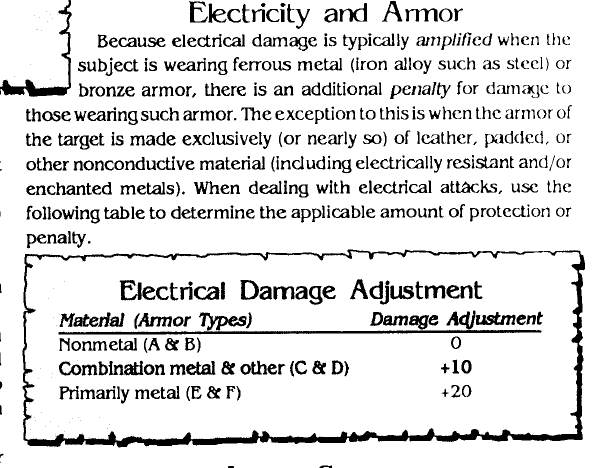
Oh Gary, what verisimilitude...
Armor costs anywhere from 750 BUCs for basic leather armor to 30,000 for full plate.
Of course, following armor, it’s on to weapons. Mythus Prime has an interesting take on ammunition. Rather than track how much ammo you’ve got, it uses a rating for how long it takes until you have to scrabble around and spend significant time looking for a new projectile. Unfortunately, it doesn’t provide this information anywhere actually in the Mythus Prime rules.
Generally, you can attack once per CT with a weapon unless it’s extremely light or magickal (basically, GM’s option). Weapon damage for a long sword is 4d6, so combat can be quite swingy if you’re rolling high on the damage or getting lots of special hits. (For comparison, full leather armor subtracts 6 points from every hit and full plate subtracts 16.) A crossbow does as much damage as a long sword, and can only fire every other round.
Spells can be cast in combat as usual, though many spells are pretty slow and take multiple CTs to cast, during which any interruption/damage taken means the spell and Heka are lost. There are both offensive and defensive uses for Heka (shields against various types of attacks/Heka use and magic miss--er, Heka darts which unerrringly hit the target, for example), as well as a mention of Mental and Spiritual attacks, which have no rules here.
Damage heals are a rate of 1 point per day (doubled if in a healer’s care); First Aid, Herbalism, and magickal healing can speed this up greatly, as usual. HPs who are Dazed are un-Dazed as soon as they drop below their Wound Level.
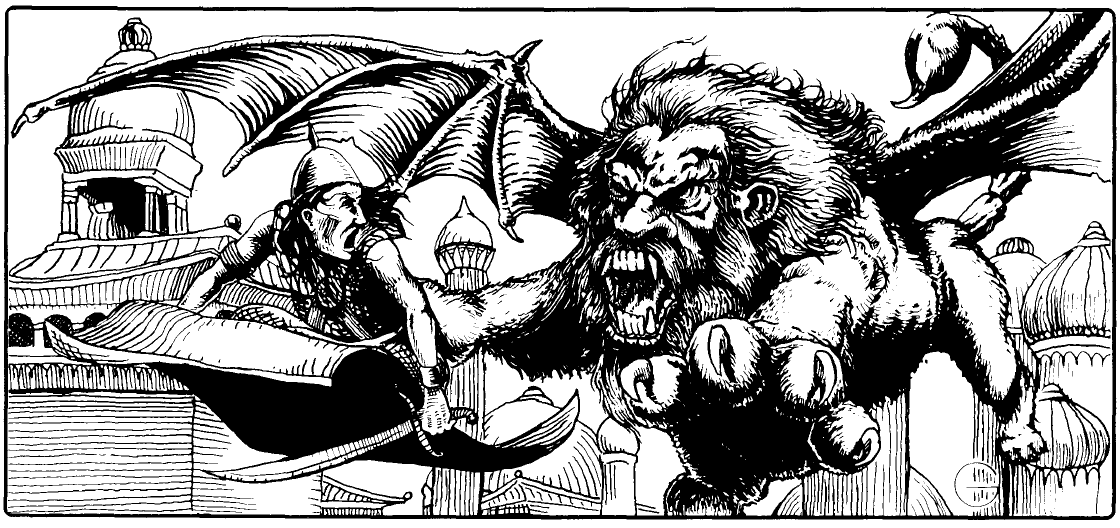
Art!
Improvement!
At the end of each scenario (determined by the GM), the HPs will get Accomplishment Points. These can be spent to increase STEEPs and Traits. A typical AP award is 5-10, depending on how well the HP did in the scenario.
STEEPs are raised on a 1:1 basis, but you can’t raise a given K/S Area by more than 5 points in a game month. New K/S Areas can be acquired for 5 points, and have a starting STEEP of 5. Traits are raised at a 1:3 basis., but raising a Trait has no affect on K/S Area STEEPs.
Playing Your HP
Gary’s got some ..fairly decent advice for players in here, actually. The GM advice is a bit spotty, but not too bad.
Gary Gygax posted:
Roleplaying Expertise
You aren't the HP, but the HP is yours. Without you, the HP wouldn't exist in the game milieu that the gamemaster builds for you. The campaign would be abridged without your input as a player--that is, your interaction in adventures via the HP. As you actively roleplay, contribute to the group's problem-solving ability, utilize the knowledge and skills of your HP, and otherwise take part in the activity, each and every participant benefits. To do this properly, however, you need to "know" your Heroic Persona.
The most important aspect of roleplaying is, well, roleplaying. The more that players can perfect their ability to project their Heroic Personas' personality, the better. Roleplaying skills improve the quality of the game and increase enjoyment. After all, the purpose of the game is not to be Matt, Cameron, Dave, and Michele fighting mythic beasts and journeying on epic quests. The purpose is to assume the character, inclinations, qualities, and faults of Balthasard, Bryn, Trevyn, and Miranda, the Heroic Personas, as they struggle to survive and conquer awesome monsters, discover ancient secrets, and so on.
(1) Develop and know your HP.
(2) Know the game and the campaign.
(3) Know real facts, especially those which relate to your HP.
(4) Know about the genre of fantasy.
If another player seems to know more and play better than you, don't hesitate to follow the example and learn from the individual. Conversely, try to help those who don't do as well to become better players. Not all GMs are expert, either--in fact, they can learn a lot from their players. If you can assist in that process, then please do, but manage it with a friendly attitude and a lot of tact. Some GMs might be too generous, and that's as bad as those who are too hard on HPs and don't give sufficient rewards (Accomplishment Polnts, etc.) for good play. Some GMs loathe to ever have an HP lost, others eliminate them with the slightest excuse--or for no reason at all! Again, very bad gamemastering! You and the others should talk to the GM about problems such as that, for you all want a fun, exciting, and long-lived campaign. Don't hesitate to point out things that you think might be interesting to encounter, adventure scenarios which would be fun, and ideas regarding the game, systems, and rules that you don't think are right. All that is done before or after play sessions, and not when the GM is in the middle of an adventure, for you don't want to disrupt the game. Here are those points again:
(1) Learn from your fellow players.
(2) Help your fellow players to be better.
(3) Assist the gamemaster to be the best.
(4) Be considerate of all the others in the group.
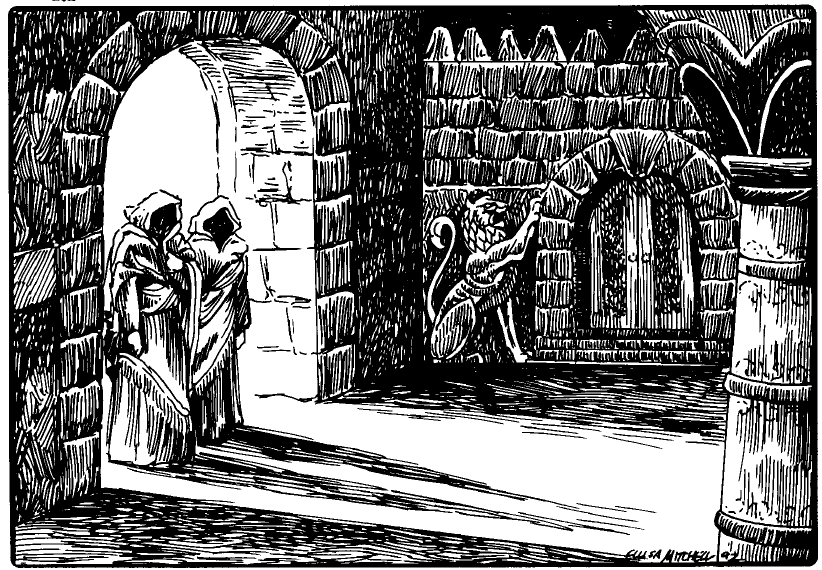
More art! woo!
Gary then gives us a pretty lengthy example of play, followed by a quick analysis and a bit more GM advice: basically, Rule Zero, some stuff is deliberately vague, play it by ear, etc. Players desiring greater complexity and “more realism” are directed to the Advanced Mythus section of the book.
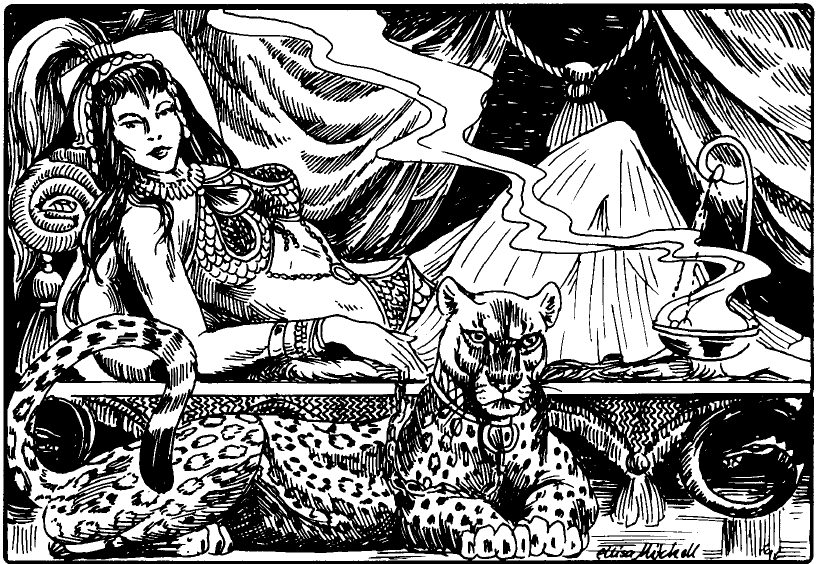
Three! Three pieces of art!
After this is a quick section to converting Mythus Prime to Advanced Mythus. There’s a lot of grunt work to do it, as there’s 24 more attributes, STEEPs are calculated a bit differently, and generally everything gets buried under 400 tons of useless chrome, but the basic mechanics are the same.
Milieu count: 7
Next up: The gamemaster’s section, including the first of two horrible introductory adventures!